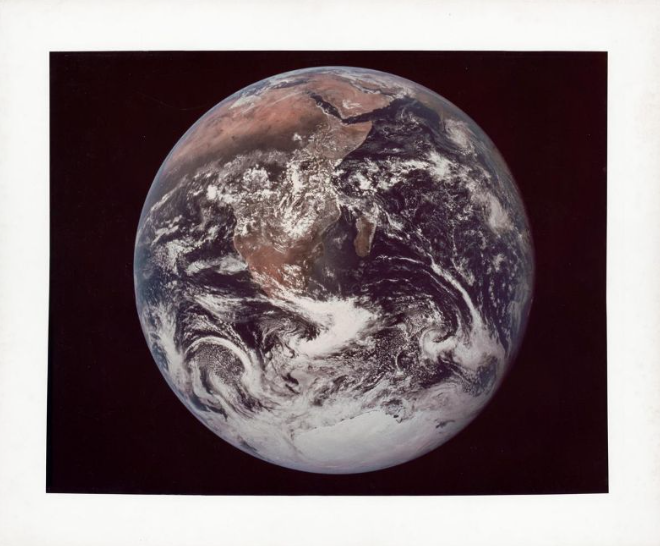Space Mission
Apollo 17, 7-19 December 1972
Photographer
NASA
Photo Description
Vintage presentation chromogenic print, large format16 x 20 in (40.5 x 51 cm), flush-mounted on original NASA card 20 x 24 in (51 x 61cm), [NASA photo No AS17-148-22727], with NASA caption numbered “72-HC-928” and “72-H-1578” on original NASA sheet pasted on verso (NASA Headquarters). The photo comes from the collection of NASA executive James Foster Fanseen, who served as political liaison during the 1980s.
Essay
“This fabulous large format presentation vintage chromogenic print shows the most reproduced photograph in the entire history of photography.
Only this final Apollo 17 mission saw the Earth fully illuminated. This iconic photograph taken through the 80mm lens from a distance of about 30,000 km was credited to Schmitt who took most of the photographs of the Earth on the way to the Moon but there is a possibility that Ron Evans shot it (see mission transcript). All Apollo flights were heavily scheduled down to the minute. At the time this photo was taken, none of the astronauts was scheduled to do so. Thus this photograph was taken quickly in a stolen moment.
The photograph was released by NASA on Christmas Eve, four years to the day after the Apollo 8 Earthrise, and the image soon became known as the “Blue Marble,” probably the most widely distributed image in history. Noteworthy NASA photo editors cropped the black sky of space to make the Earth appear bigger than originally captured on film by the astronauts.
“This now famous picture of the Earth, taken from about 34,000 miles away [18,000 statute miles in fact], shows all of Africa, the continent of human origins and later migrations. […] In spite of the personal motivations for the descriptions and photographs, when I took this picture, I could not help but be struck by the remarkable fact that humans from that now receding blue, green, red-yellow, and white globe could take such a picture. A new migration to places elsewhere in the solar system had begun. As a geologist, I also reflected on how much our Home Planet had endured over four and a half billion years of time, demonstrating a truly remarkable resilience to apparent diversity.”
—Harrison Schmitt
From the mission transcript when the “Blue Marble” photograph was taken (at about T+005:06:24 after launch):
005:03:10 Evans: Oh, I’ll change the lens now.
005:03:11 Overmyer (Mission Control): 17, Houston. It’s about 30 seconds from the (SIVB) evasive maneuver burn.
005:03:17 Cernan: Okay.
005:03:19 Evans: Here, Jack, can you see him (the discarded SIVB) good? Check the settings there. I took an f/22 stop.
005:03:51 Cernan: There it goes, Bob.
005:03:52 Evans: There it goes; finally. […]
005:08:38 Evans: Houston, (Hasselblad) magazine November November is on about 123 right now. […]
005:17:37 Schmitt: That view of the Earth for a rev there was something I was looking forward to and I was not disappointed.
005:17:49 Overmyer (Mission Control): That’s great, Jack. […]
005:19:00 Cernan: Bob, Antarctica is what I would call effectively just a solid white cap down on the – South Pole. There’s definite contact between the continent and the water. But, as Ron said, most of the clouds seem to be, well very artistic, very picturesque – some in clockwise rotating fashion but appear to be very thin where you can, for the most part, kind of see through those clouds to the blue water below. […]
005:21:07 Schmitt: Could you give us our distance from the Earth ? […]
005:21:24 Overmyer: 18,100 [nautical miles, 33,520 km], FIDO (Flight Dynamics Officer) says. […]
005:21:27 Cernan: Okay. And I suppose we’re seeing as 100 percent full Earth as we’ll ever see; certainly as I’ve ever seen. It appears to be – it may be a little bit – a little bit of a terminator way out to the – well, to the east – out beyond Australia and beyond India. But beyond that it’s about 99 percent pure.
005:22:59 Cernan: Bob, it’s these kind of views – these kind of views that stick with you forever. […]
005:25:56 Cernan: You know – and there’s no strings holding it up either. It’s out there all by itself. […]
005:49:47 Overmyer (Mission Control): Did you get any pictures of that, Jack?
005:49:50 Schmitt: Oh, yes. We got some pictures earlier. I’m going to get another one here in a minute. I’ll tell you, if there ever was a fragile-appearing piece of blue in space, it’s the Earth right now.”
